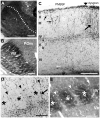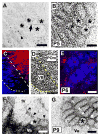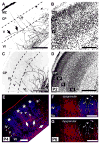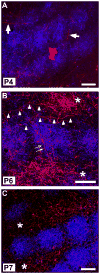Developmental and comparative aspects of posterior medial thalamocortical innervation of the barrel cortex in mice and rats
- PMID: 18496871
- PMCID: PMC4913357
- DOI: 10.1002/cne.21690
Developmental and comparative aspects of posterior medial thalamocortical innervation of the barrel cortex in mice and rats
Abstract
The thalamocortical projection to the rodent barrel cortex consists of inputs from the ventral posterior medial (VPM) and posterior medial (POm) nuclei that terminate in largely nonoverlapping territories in and outside of layer IV. This projection in both rats and mice has been used extensively to study development and plasticity of highly organized synaptic circuits. Whereas the VPM pathway has been well characterized in both rats and mice, organization of the POm pathway has only been described in rats, and no studies have focused exclusively on the development of the POm projection. Here, using transport of Phaseolus vulgaris leucoagglutinin(PHA-L) or carbocyanine dyes, we characterize the POm thalamocortical innervation of adult mouse barrel cortex and describe its early postnatal development in both mice and rats. In adult mice, POm inputs form a dense plexus in layer Va that extends uniformly underneath layer IV barrels and septa. Innervation of layer IV is very sparse; a clear septal innervation pattern is evident only at the layer IV/Va border. This pattern differs subtly from that described previously in rats. Developmentally, in both species, POm axons are present in barrel cortex at birth. In mice, they occupy layer IV as it differentiates, whereas in rats, POm axons do not enter layer IV until 1-2 days after its emergence from the cortical plate. In both species, arbors undergo progressive and directed growth. However, no layer IV septal innervation pattern emerges until several days after the cytoarchitectonic appearance of barrels and well after the emergence of whisker-related clusters of VPM thalamocortical axons. The mature pattern resolves earlier in rats than in mice. Taken together, these data reveal anatomical differences between mice and rats in the development and organization of POm inputs to barrel cortex, with implications for species differences in the nature and plasticity of lemniscal and paralemniscal information processing.
Copyright 2008 Wiley-Liss, Inc.
Figures














Similar articles
-
Thalamic afferents of the rat barrel cortex: a light- and electron-microscopic study using Phaseolus vulgaris leucoagglutinin as an anterograde tracer.Somatosens Mot Res. 1993;10(1):1-16. doi: 10.3109/08990229309028819. Somatosens Mot Res. 1993. PMID: 8484292
-
Developmental patterns of cadherin expression and localization in relation to compartmentalized thalamocortical terminations in rat barrel cortex.J Comp Neurol. 2002 Nov 25;453(4):372-88. doi: 10.1002/cne.10424. J Comp Neurol. 2002. PMID: 12389209
-
Corticofugal axons from adjacent 'barrel' columns of rat somatosensory cortex: cortical and thalamic terminal patterns.J Anat. 2000 Apr;196 ( Pt 3)(Pt 3):379-90. doi: 10.1046/j.1469-7580.2000.19630379.x. J Anat. 2000. PMID: 10853960 Free PMC article.
-
Synaptic biology of barrel cortex circuit assembly.Semin Cell Dev Biol. 2014 Nov;35:156-64. doi: 10.1016/j.semcdb.2014.07.009. Epub 2014 Jul 28. Semin Cell Dev Biol. 2014. PMID: 25080022 Review.
-
Re: Woolsey TA, van der Loos H. 1970. The structural organization of layer IV in the somatosensory region (S I) of mouse cerebral cortex. Brain Res. 17: 205-242.Brain Res. 2016 Aug 15;1645:22-4. doi: 10.1016/j.brainres.2016.04.029. Epub 2016 Apr 14. Brain Res. 2016. PMID: 27086973 Review.
Cited by
-
Maturation and circuit integration of transplanted human cortical organoids.Nature. 2022 Oct;610(7931):319-326. doi: 10.1038/s41586-022-05277-w. Epub 2022 Oct 12. Nature. 2022. PMID: 36224417 Free PMC article.
-
Dimensions of a projection column and architecture of VPM and POm axons in rat vibrissal cortex.Cereb Cortex. 2010 Oct;20(10):2265-76. doi: 10.1093/cercor/bhq068. Epub 2010 May 7. Cereb Cortex. 2010. PMID: 20453248 Free PMC article.
-
In Vivo Visualization of Active Polysynaptic Circuits With Longitudinal Manganese-Enhanced MRI (MEMRI).Front Neural Circuits. 2018 May 22;12:42. doi: 10.3389/fncir.2018.00042. eCollection 2018. Front Neural Circuits. 2018. PMID: 29887796 Free PMC article.
-
A sharp cadherin-6 gene expression boundary in the developing mouse cortical plate demarcates the future functional areal border.Cereb Cortex. 2013 Oct;23(10):2293-308. doi: 10.1093/cercor/bhs221. Epub 2012 Aug 8. Cereb Cortex. 2013. PMID: 22875867 Free PMC article.
-
Organization of myelin in the mouse somatosensory barrel cortex and the effects of sensory deprivation.Dev Neurobiol. 2013 Apr;73(4):297-314. doi: 10.1002/dneu.22060. Epub 2012 Nov 26. Dev Neurobiol. 2013. PMID: 23047707 Free PMC article.
References
-
- Abdel-Majid RM, Leong WL, Schalkwyk LC, Smallman DS, Wong ST, Storm DR, Fine A, Dobson MJ, Guernsey DL, Neumann PE. Loss of adenylyl cyclase I activity disrupts patterning of mouse somatosensory cortex. Nat Genet. 1998;19:289–291. - PubMed
-
- Ahissar E, Sosnik R, Haidarliu S. Transformation from temporal to rate coding in a somatosensory thalamocortical pathway. Nature. 2000;406:302–306. - PubMed
-
- Ahissar E, Sosnik R, Bagdasarian K, Haidarliu S. Temporal frequency of whisker movement. II. Laminar organization of cortical representations. J Neurophysiol. 2001;86:354–367. - PubMed
Publication types
MeSH terms
Grants and funding
LinkOut - more resources
Full Text Sources

